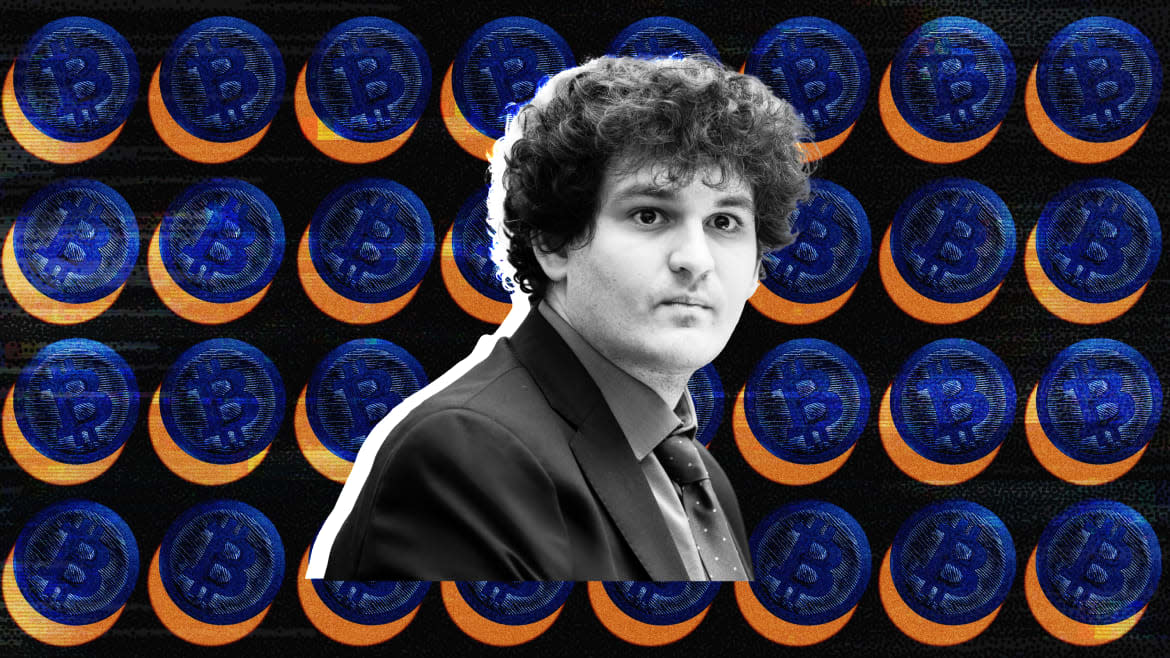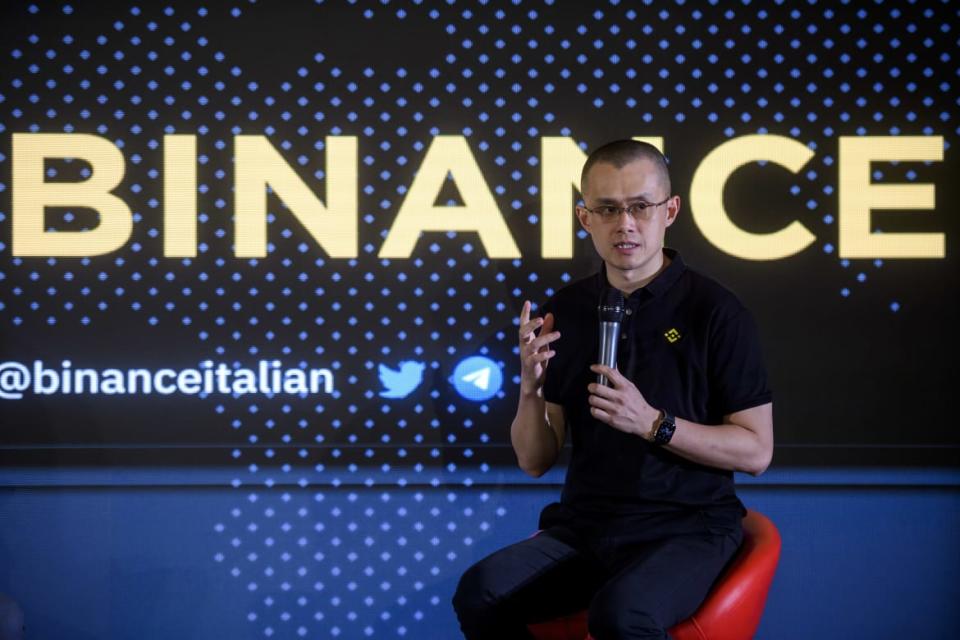Crypto Poster Boy Sam Bankman-Fried’s Meltdown

- Oops!Something went wrong.Please try again later.
Another financial disaster is roiling the crypto markets, this time at FTX, the massive cryptocurrency exchange run by Sam Bankman-Fried, who had positioned himself as the poster boy of responsible crypto investing.
On Tuesday, that narrative collapsed when Bankman-Fried abruptly announced that FTX would be acquired by one of its biggest competitors, Binance, amid speculation that the firm faced a dire liquidity crunch.
Just a week ago, FTX—the third-largest exchange in the world, by trading volume—looked too big to fail. Bankman-Fried, a 30-year-old MIT grad whose office attire consists of shorts and T-shirts, had graced magazine covers, lobbied American regulators and Congress members, and emerged as a major Democratic donor.
Bankman-Fried—or SBF, as his stans call him—seemed to be branding himself as a modern J.P. Morgan, snapping up undervalued assets and distinguishing his firm through fiscal restraint. When crypto companies needed bailing out, his firm loaned them money. In June, in the wake of a separate cryptocurrency collapse, SBF publicly warned about "third-tier exchanges" that he believed were already "secretly insolvent"—implying that FTX was better managed.
Tuesday’s events cast doubt on that depiction, sparking fervor and panic in the market.
“[Bankman-Fried] was like the grown-up in the room, the stabilizing voice of reason,” David Yermack, a professor at the New York University Stern School of Business, told The Daily Beast. “And it turns out there was nothing there.”
What exactly happened to Bankman-Fried and FTX, and what does it all mean? Read on to find out.
What is FTX? What is Binance?
Binance and FTX are the biggest and third-biggest cryptocurrencies exchanges in the world, respectively. Crypto enthusiasts use them to trade more than a hundred-billion dollars in crypto each day and to cash out their holdings if they’d like to spend the money in fiat currency—like U.S. dollars. Binance was an investor in FTX until last year, when Bankman-Fried bought out all the company’s shares. There were rumors of a rivalry between SBF and Binance founder Changpeng Zhao at the time, but it didn’t come to a head until this fall, when both companies made a bid for the insolvent crypto lender Voyager Digital. FTX eventually won with a $1.4 billion bid—part of a buying spree Bankman-Fried went on after the crypto market crashed this spring. Between these purchases and the millions of dollars in loans his company offered up to failing blockchain companies, Bankman-Fried was being hailed as a “savior” of crypto.

Founder and CEO of Binance Changpeng Zhao.
What happened last week?
The crypto-focused news site Coindesk published an article suggesting SBF’s companies weren’t as solvent as they seemed. Specifically, it claimed Bankman-Fried’s trading firm, Alameda Research, had most of its assets tied up in a crypto token issued by FTX called FTT. The details were complex, but this essentially suggested that much of Bankman-Fried’s ballyhooed billions were locked in a relatively risky token issued by one of his own companies.
Zhao then tweeted that Binance would start selling off all of its FTT tokens, due to “recent revelations that have [come] to light.” His announcement triggered a spree of other sell-offs, leading to what’s known in the crypto world as a “death spiral.” Just 24 hours after Zhao announced the liquidation, the value of FTT had dropped 22 percent.
Yermack compared the collapse to a traditional bank run, similar to what happened to Bear Stearns in 2008. “It’s a very old problem in finance — we've had bank runs for thousands of years,” he said. “In this case, the technology is just a little bit different.”
Bankman-Fried assured customers that FTX was doing well and that it had “enough to cover all client holdings.”
“FTX is fine. Assets are fine,” he tweeted Monday morning.
But he would quickly change his tune.
What happened Tuesday?
Bankman-Fried returned to Twitter to admit that all was not well. In a shocking about-face, he announced that he had agreed to sell FTX to Binance for an undisclosed sum, in order to fully cover all of its customers' assets and “clear out liquidity crunches.” In his own Twitter thread, Zhao confirmed that Binance had signed a non-binding letter of intent “intending to fully acquire FTX.com and help cover the liquidity crunch.” FTX US and Binance US, the companies’ smaller, U.S.-only exchanges, would not be affected.
The announcement sent shock waves—and more than a little profanity—through the industry.
“Holy shit,” prominent Bitcoin proponent Dan Held tweeted.
BINANCE JUST BOUGHT FTX!? WTF— AFTER ALL THE FIGHTING?! https://t.co/xnPa4fWBld
— Coffeezilla (@coffeebreak_YT) November 8, 2022
Now what?
The ramifications of the proposed merger were not immediately clear. Zhao cautioned on Twitter that the situation was “highly dynamic,” and that Binance maintains the discretion to pull out at any time. “We expect FTT to be highly volatile in the coming days as things develop,” he tweeted.
Bankman-Fried was largely silent on what the merger meant for him, and a spokesperson declined to comment. But according to Forbes, which this year deemed him “one of the richest people in crypto,” much of his wealth is tied up in Alameda and FTT—meaning their crash could cut into his personal worth.
Experts told The Daily Beast it would likely take weeks for the particulars of the deal to be worked out.
“Whatever the situation is right now, it could look differently in six hours,” Yermack said. “Until the dust settles, nobody really understands what the implications are.”
What does this mean for crypto and the economy?
No matter what happens to Bankman-Fried, the sudden crash of FTX could deal a major blow to confidence in crypto markets and the industry. The billionaire was one of crypto’s most promising success stories, and his collapse would likely rattle both professionals and casual investors, experts said.
“This episode highlights the vulnerability of the entire crypto edifice to swings in investor confidence,” Eswar Prasad, an economics professor at Cornell University, told the Beast. “Even large and apparently financially solid institutions turn out to have wobbly foundations that crumble at the least hint of trouble.”
The episode is especially salient following this spring’s dramatic crypto crash, which wiped out more than $2 trillion in just months. And experts said it may give Congress and other regulators cause to clamp down on crypto markets, which have traded with comparatively few regulations.
Some crypto-watchers, however, don’t think FTX’s troubles are the death knell of crypto. William Quigley, a venture capitalist and crypto entrepreneur, said investors should be used to this kind of roller-coaster ride—and predicted they won’t be getting off anytime soon.
“If there’s anything we have become used to in crypto, it’s enormous surprises on the upside and the downside,” he said.
Get the Daily Beast's biggest scoops and scandals delivered right to your inbox. Sign up now.
Stay informed and gain unlimited access to the Daily Beast's unmatched reporting. Subscribe now.

